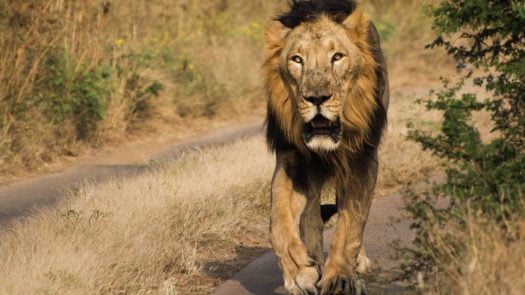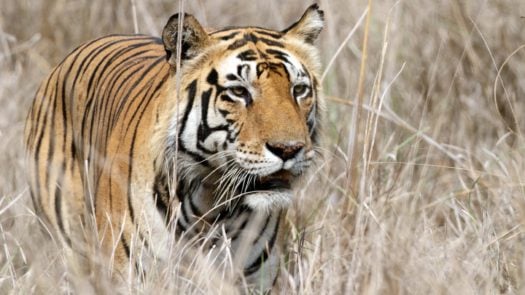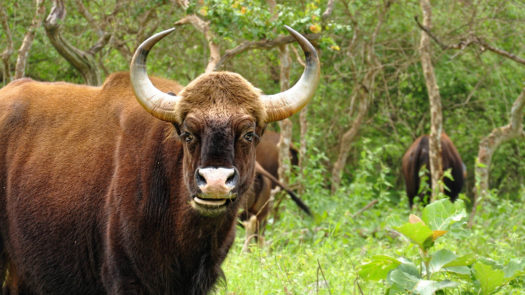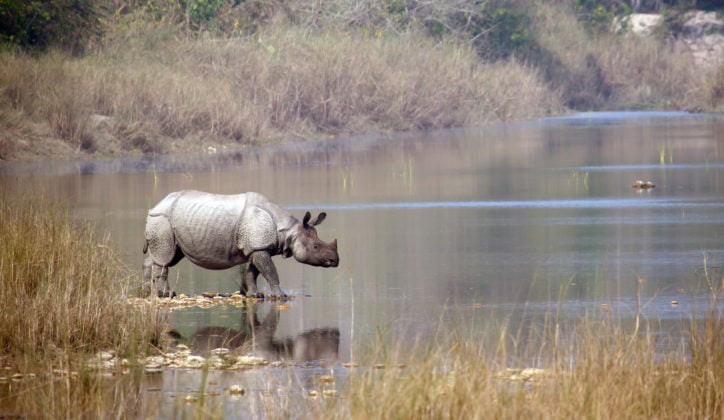Published on: October 31st, 2018
Last updated: July 28th, 2023
India is a real life jungle book, with incredible wildlife that includes Bengal tigers, Indian leopards and Asiatic lions. There’s nowhere else in the world that offers such unique wildlife spotting experiences.
Ranthambore, Bandhavgarh and Kanha are home to some of the country’s highest tiger populations, while the luxurious and remote JAWAI is the best place to catch a glimpse of the elusive leopard. Here's our guide to seeing the big cats of India.

Bengal Tigers in Bandhavgarh National Park
Home to the highest known density of Bengal tigers in the world, Bandhavgarh is one of India’s most popular national parks for tiger spotting. This park has a longstanding history, with the ancient ruined fort thought to be 2000 years old. The forests were long maintained as a preserve for the Maharajas and their guests, so it has been a tiger-friendly environment for centuries. The park has an area of over 500 square kilometres (200 square miles) and habitats range from rugged hills to wide open valleys and grasslands. There is a rich biodiversity to be found here; along with tiger, the park is home to leopards, sloth bears, dholes, Indian bison and spotted deer.

Mahua Kothi and Samode Safari Lodge are excellent bases from which to explore the surrounding National Park. Both offer traditional Indian villas, lit up at night with the twinkling of candles and hurricane lamps. For explorers, there is plenty of opportunity to cycle or go for nature walks along trails near the lodge, as well as the expected daily tiger safari drives.


Asiatic lions in Gir Forest National Park
Gir Forest National Park is located in the western state of Gujarat, which is the last remaining stronghold of the Asiatic lion. This national park is a vitally important protected forest that is home to the last remaining population of the Asiatic lion in the world. This iconic big cat once ranged across India, the Middle East and Turkey but was hunted down to just 20 animals in the early 20th century. Since then, conservation efforts in the park and wider sanctuary saw numbers return to over 650 in 2017. The Asiatic lion is the state animal of Gujarat and many locals live in astonishingly close proximity with their feline neighbours.

Prides of Asiatic lion tend to be small, usually containing a couple of females and cubs, with males protecting small territories. While in the area, you can spend your days exploring the park on private morning and afternoon game drives. As well as tigers, you’ll have the opportunity to spot leopards, striped hyenas, pangolins and jungle cats. Birdlife is also prolific, with some 300-species recorded in the park. Stay at the aptly named Lion Safari Camp, located in a private mango orchard on the edge of Gir National Park. You can either venture into the park to seek out the Asiatic lions and other wildlife, or soak in the rich cultural heritage that the park is grounded in.


Snow leopards in Ulley, Ladakh
Nestled in the Northern state of Jammu and Kashmir lies one of India’s most remote and sparsely populated areas, Ladakh. Often referred to as Little Tibet, Ladakh is a land of snow capped mountains, vast barren plateaus and turquoise lakes. Sitting at an altitude of 3,500 metres, it’s also a state which is famed for leopard spotting opportunities. On your way out from Ladakh’s capital Leh, a mountainous road follows the Indus River before heading north into snow leopard country. Eventually, the road arrives at the aptly-named Snow Leopard Lodge, located in the heart of the Ulley Valley.

The Snow Leopard Lodge is the only dedicated wildlife lodge in Ladakh. It originally opened as a homestay owned by one of Ladakh’s top snow leopard trackers – Tehewang Norbu – as part of a program initiated by the Snow Leopard Conservancy. This program was designed to use tourism as a conservation tool for the preservation of snow leopards by putting revenue directly into the local community. As a result, The Snow Leopard Lodge is a positive impact champion and comfortable homestay in prime leopard country.

Generally, snow leopard spotters head out at the crack of dawn to search for signs of the almost phantom-like feline. Based on the morning’s findings, the chief spotter will lay out the day’s plan over a hearty breakfast. You could be trekking straight from the lodge, or driving to distant valleys to then trek up to vantage points. Sightings are by no means guaranteed, but this adds to the fun of the search. Incredible landscapes and other wildlife make it a unique experience, even if you don’t see the cats.

Snow leopards are impressive animals who survive the bitter winter of the Himalayas due to their thick and perfectly camouflaged fur coats. Their huge feet – covered in insulating fur – act as snow shoes, while their long tails help them to keep their balance in the rocky terrain. Snow leopards are solitary beings, except when with cubs or mating, so they are very hard to spot. Although these magnificent felines are the main attraction in Ladakh, you can also spot Eurasian lynx, red foxes, golden eagles and Tibetan wolves.


Ranthambore National Park’s Tigers
Ranthambore National Park is one of the best places in India to see tigers in their natural habitat. The best time to visit is from November to April; the park is closed to visitors during monsoon season – between July and September. Ranthambore’s tiger population was brought back from the brink of extinction last century, and the population is now so dense that some tigers have even been relocated to add diversity to neighbouring national parks.

The atmosphere feels truly magical here – ancient temple ruins are peppered with wandering tigers, bathed in India’s golden late afternoon light. The forests here are also alive with the alarm calls of chital and sambar deers, galloping nilgai, leopards, striped hyenas, loping sloth bears and wild boars. The lakes are brimming with crocodiles and 272 species of bird. On a shared tiger safari, you’ll drive through the park in search of the awe inspiring creatures with an expert guide who knows the park and its tigers inside out.


JAWAI, Rural Rajasthan
India’s largest state is peppered with traditional villages and fortresses in rugged mountains. Set amongst the expansive red sands of the Thar desert, Rajasthan is other-worldly. In the Aravalli hills between Udaipur and Jodhpur, luxurious safari camp JAWAI is an incredible place from which to head out on leopard safaris and walk with fascinating Rabari herdsmen. There are just nine luxurious canvas tents here, including a family suite. Each spacious suite comes with an en suite bathrooms private veranda and a seating area that looks out over the wilds.

There are plenty of ways to discover rural Rajasthan from this heavenly base. You can spend your days taking game drives to spot leopards and other wildlife, taking part in birdwatching walks or joining shepherds for more challenging treks. The opportunity to travel in 4×4 jeeps with the camp’s experienced leopard trackers in the morning and the evening is a real highlight. When you’re out on the evening drive, you’ll be able to see what is known in India as “Gaudhuli,” or cow dust hour. The name results from the dust kicked up by cattle as they leave or return home at this hour, and it’s a magical time to be out in the countryside.

Sunrise and sunset are considered auspicious times in India. As you drive through the village, you will be able to see small rituals performed to welcome in the night, adding to the excursion’s ethereal feel. Aside from leopard spotting, you can visit nearby temples and forts, go mountain biking or relax with yoga sessions in secluded parts of the desert.


The best of the rest
Kanha Tiger Reserve, Madhya Pradesh
Right in the heart of central India, Kanha Tiger Reserve is the largest national park in Madhya Pradesh. The park covers some 640 square kilometres (360 square miles) and is regarded as one of the best parks in the country for tiger safaris. With a wonderful diversity of forest and meadows, this deep tiger-filled jungle is inspiring.

A variety of enigmatic wildlife resides here, including leopards, Indian wild dogs, sloth bears, gaur bulls and a species of barasingha swamp deer that is now only found in Kanha. Birdlife is also prolific here, with some 300 species in the area. Compared to other national parks, majestic predators are slightly more elusive here. This means you really get to experience the park as you search for them, and sightings are a rewarding affair.

Stay in the chic Banjaar Tola camp for an intimate safari experience. There are 18 tents here, split into two groups of nine to add to the private feel. Each feature bamboo floors and canvas walls with glass doors leading out onto a floating veranda with beautiful views over the river. Between the twice daily game drives, you can spend your time watching the incredible wildlife from the swimming pool or reading up on it in the library.

Panna National Park, Madhya Pradesh
Also in Madhya Pradesh, Panna National Park is renowned for waterfalls and wildlife. At the heart of this national park is the River Ken. This bountiful river winds its way through a vast expanse of plateaus, gorges and thick forest. The park is best explored after the rains have fallen, when it becomes a lush green blanket of vegetation, interspersed with cascading waterfalls.

Panna was once a royal hunting ground before becoming a national park in 1981, so the park’s tiger population has suffered in the past with poaching. An ongoing translocation program, however, has injected hope for the future; new tigers are being brought in from nearby parks to breed and increase numbers. Although tiger sightings are not guaranteed, the park is also home to elusive leopards, wild dogs, hyenas, sambar deer, nilgai, chinkara antelopes and crocodiles.

Our top wildlife trips in India...
Feeling inspired? Get in touch with one of our expert travel designers to start planning your wildlife tour of India.






